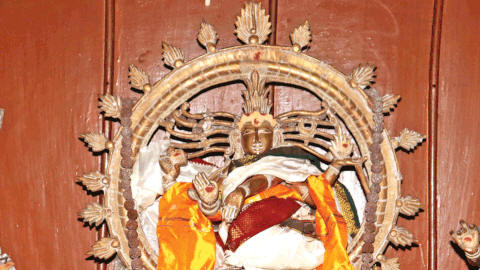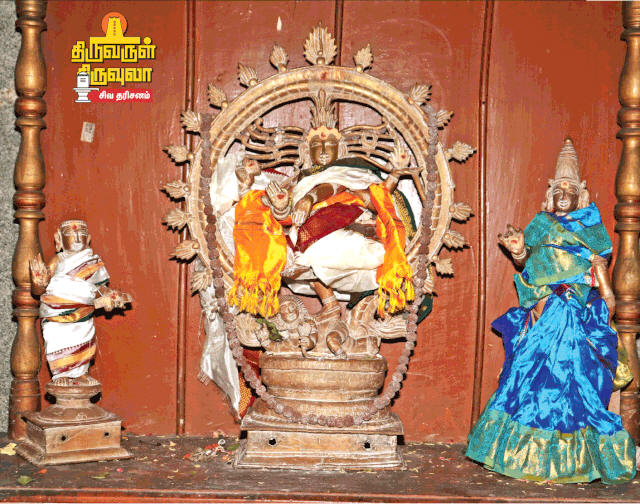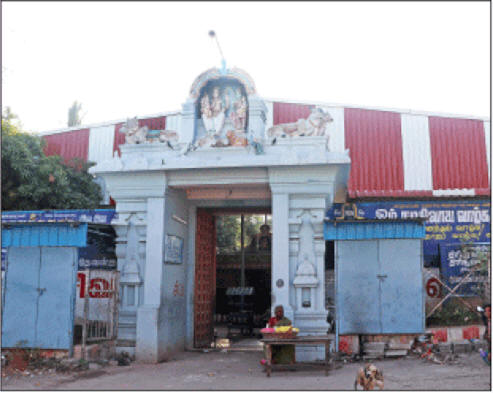Published:10 Feb 2020 7 PM Updated:10 Feb 2020 7 PM Sakthi Vikatan
சக்தி கொடு! – 20 Give Sakthi - 20
Sakthi Vikatan Team Rakesh P

2. Goad holder is the Elephant-faced God (Ganesa). Spear holder is Murugapperumāṉ. Conch holder is Viṣṇu. Trident holder is Śivaperumāṉ and Ambāḷ. The holder of flower is Sāsthā
Comment: ஐயப்பன், ஐயனார், சாத்தன், சாஸ்தா என்கிற எல்லா பெயர்களும் குறிப்பது சாத்தனைத்தான். சிலப்பதிகாரத்திலேயே சாத்தனைப் பற்றிய குறிப்பு உண்டு. தமிழகம் முழுவதும் சாத்தன் வழிபாடு இருந்ததுண்டு.
3. What is the basic truth in applying weapons in the hands of the deities?
4. Only the divine grace will ward off evil and send us in the path of virtue. Our spiritual books have placed the divine grace in the form of weapons in the hands of the deities. Let us look at the trident as the basis and receive Darsan in its name at the Trident sacred temples.
5. We might have seen the Trident in the holy hands of Śivaperumāṉ and Ambāḷ. We would have had a Darsan of the sacred form of Durgai as she stood by the neck of Mahiṣāsuraṉ with the trident looking head down at Mahiṣaṉ.
6. Why that way? Why does the Trident have three tines?

8. No matter who the culprit is, a person does not do it wantonly; desire instigates the person; when the desire does not find fulfilment, anger springs forth; because of anger, ignorance – delusion – dictates our actions. We get into difficulties.
9. Lust, anger and delusion are the triad.
10. The causal factors (author calls it 'a disease') sully the good name. That is the saying of Vaḷḷuvar. Desire, anger and ignorance are the triad, which the three tines of the Trident remove, confering grace on us.

12. The temple and the town, embraced by nature, nestle right in the shadows of the four mountains, which stand for four Vedas. The traditional view is, Paramēṣvaraṉ, the essence of four Vedas took up residence right in the temple in the center of the town. This town, surrounded by the four mountains, shines with foursome wealth: An abundance of water, an abundance of fertile lands, an abundance of mountains, and an abundance of nature.
13. It is not a surprise that the servitors come in hoards to worship Śivaperumāṉ, full of grace and giving, and abiding in such natural surroundings. Reason? It is the temple, to which the Creator Braḥmadēvar himself came to worship! Where is the surprise when the humans, the highest of his creation, come to worship him?
14. Braḥmadēvar in charge of the portfolio of creation did austerities to Śivaperumāṉ to insure smooth and flawless performance and no impediments. Braḥmadēvar chose this temple to do his austerities! He created a pond of sacred water in the temple and dedicated the Śivaliṅgam.
15. Braḥma Tīrtham was the eponymic name of Braḥmadēvar and the water-body. Braḥmadēvar’s austerity continued. Śivaperumāṉ showing grace came down, manifested himself to Braḥmadēvar and said, “Braḥmadēvā! As you desire, your creative endeavour will continue to flourish.”
16. Because of the grace of Śivaperumāṉ to Braḥmadēvar at this temple site and offering of blessings for the success of his creation portfolio, the entrepreneurs, the seekers of Jñāṉa following Guru Upadēśam, and the neophyte-seekers of spiritual wisdom go to this temple and offer worship, which carried a special significance.
17. The eponymous name of this temple is Braḥmapuri because of the offering of Śiva’s grace and blessing to Braḥmadēvar. Śivaperumāṉ received the holy name of ‘Braḥmapurīsvarar’ (The Lord of Braḥmapuri) because Braḥma dedicated this temple and worshipped Śivaperumāṉ.
18. The Darsan of Īśaṉ’s majestic form, the cynosure of our eyes and the center of our imagination leaving an indelible impression on the mind, grants joy, serenity, and rejuvenation of energy.
19. Yes, it is originality. It is a rare sight to see Śiva and Sakthi together in the Inner Sanctum (கருவறை = karu-v-aṟai = Womb = Garbhagṛiham = sanctum sanctorum). In this sacred temple, we can receive Darsan of Īśaṉ and Ambāḷ together in Śiva’s Sannidhi. By tradition and custom, the Iṛaivaṉ’s Sannidhi and Ambāḷ’s Sannidhi are in two separate locations in the temples. Why is it they remain in one Sannidhi in this temple?
20. An Aḍiyār (Servitor) also received Darsan, grace and blessings from Śivaperumāṉ like those of Braḥmadēvar.
21. At the beginning, there existed two shrines, one for Īśaṉ and one for Sakthi. The foreigner invaders rummaged, rampaged, plundered and pillaged the temples. They entered this sacred temple and parlayed their nefarious skills.
22. The aftermath of the invasion was the idol of Ambāḷ sustained damage. Later, the officials installed and dedicated another idol (Tripurasundari) in Ambāḷ’s shrine.
23. The temple administrators decided to move the old idol out of the temple. Then, Śivaperumāṉ came in the dream of the Arcchakar (priest) and ordered him, “Arcchakarē! Do not move the Devi idol out of the temple. You install the idol near me in my shrine and dedicate it.” The temple administrators did as they were ordered by Śivaperumāṉ himself. Here we can take the unique Darsan of Śiva and Sakthi in one shrine.
24. Ambāḷ Tripurasundari own exclusive shrine is to the left of Īśaṉ’s Sannidhi. The holy name of Tripurasundari is an eponym of Trisūlanāthar, Īśaṉ’s holy name.
25. Ambikai’s visage of mercy scrubs and disposes the impurities of our mind without our knowledge. Ambikai’s merciful and anodynic Darsan consists of her self-presentation with the right posterior hand holding Rudrākṣa garland, the left posterior hand holding a flower, the right anterior hand projecting an Abhaya Mudra (Have no-fear pose), and the left anterior hand with a pose of Varatham (Boon).
26. The temple is an ensemble of multiple shrines. The multitude of stone carvings bear witness to the kings’ benevolence to the temple from the 11th century forwards. The entrepreneurs beginning their projects with the worship of Īśaṉ and Ambāḷ enjoy the guaranteed and succesful progress made in their endeavour.
27. Mahāśivarātri holy day falls on 21st February, 2020. On this auspicious day, let us go to this historical and meritorious temple and receive Darsan. Trisūlanāthar, who gave Braḥmadēvar grace and blessings, and Aṉṉai Tripura Sundari will confer on us the boons for the fructification of our new plans and projects and for the enrichment of our life.
More to come.